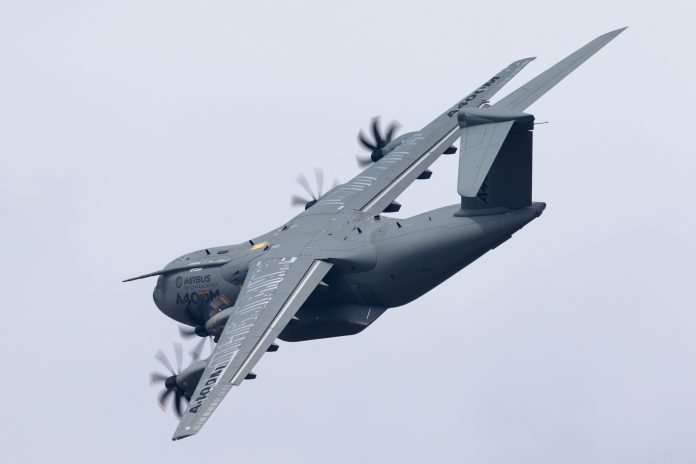Sustainable aviation fuels are gaining prominence as viable alternatives to fossil fuel in the civil aviation sector – so what will this mean for military aircraft? James Domone, Principal Engineer, Atkins explores here
For the UK Government, decarbonising military operations isn’t optional. As it seeks to achieve net-zero CO₂ emissions by 2050, the Government must start to ensure that every penny spent in procuring new goods and services is a green penny.
This will, of course, bring challenges; aircraft have a voracious appetite for fuel, and safety must always come first. But new breakthroughs are emerging all the time, so to build back greener after Covid we must understand and embrace the changes that net-zero will inevitably bring.
Sustainable aviation fuel
In February 2021, Rolls-Royce announced it had conducted its first tests of 100% sustainable aviation fuel (SAF) in a business jet engine, as part of its “ongoing ambition to play a leading role in enabling the sectors in which we operate reach net-zero carbon by 2050.” And, in December 2020 the UK Government revised aviation fuel standards to permit SAF to be added to military registered aircraft up to a level of 50%, mirroring the same move that had already been made for commercial aerospace.
Could this represent a first for aviation; a breakthrough in commercial flight R&D coming before a new innovation in defence? As the quest for greener travel moves apace, it’s important to get a snapshot of where we are now in terms of what’s viable and what’s possible for fuelling civil or military aircraft.
e-fuel
In short, there are three groups of sustainable fuel alternatives to kerosene. First, is SAF, produced from sustainable feedstocks such as farmed biological material, used cooking oil, or solid waste such as packaging that would otherwise go into landfill or be incinerated – Air bp’s SAF is currently made from used cooking oil and animal waste fat. Second, comes e-fuel, similar to SAF but it’s synthetically derived using the Fischer-Tropsch process, which combines carbon – that can, for example, be sucked from the air or seawater – with hydrogen, to produce a synthetic hydrocarbon fuel.
It’s important to add here that these two fuels require little or no modification to current jet engines, as also announced by Rolls-Royce in its trials: “our current engines for large civil and business jet applications can operate with 100% SAF as a full “drop-in” option, laying the groundwork for moving this type of fuel towards certification.” So, the fundamental design of the aircraft, its performance, and the way that it produces propulsion remains the same.
Hydrogen
The third option is hydrogen; a fuel source for aeroplanes that have been studied since the 1930s, with recent interest reignited following investment in the electric vertical take-off and landing (evTOL) sector by Hyundai and the French Government via the European Union Clean Sky initiative. This white paper explains the pros and cons of hydrogen in more detail, but the headline issues with hydrogen are that it requires significant modification to existing jet combustion engines, or substitution with fuel cells and electric propulsion systems, plus a whole new infrastructure to produce, transport and store it. It also needs extra aircraft capacity to carry it and production of so-called ‘green’ hydrogen is critical to achieving net-zero.
All three of the above, however, can be produced where you have a water supply, and an electricity supply. Within the defence context, if troops are deployed overseas this means no need for reliance on local fuel supplies, pipelines or tanks; you have the means of creating your own fuel, in situ. You could even produce SAF from waste produced on the military base. Hydrogen would only require water, power, and an electrolyser, which could easily be produced using portable units. So, despite their current limitations, the production of these fuels should be perceived as beneficial in terms of it being a more mobile and agile process.
All three are technically viable, SAF being the more mature of the three. It’s already in use, albeit in extremely small quantities: less than half of one percent of the globe’s aviation fuel usage. With the next UK fighter jet, Tempest, expected to launch around 2040 there’s little doubt it will be fuelled by SAF due to the size and power of a jet aircraft. But let’s not write off hydrogen which, despite its capacity issues, could play an important future role in military training aircraft and cargo planes, by 2040 to 2050. In 2020 Airbus revealed three concepts for the world’s first zero-emission commercial aircraft which could enter service by 2035, relying on hydrogen as a primary power source.
Arguably, the biggest barrier to accelerating the immediate rollout of all three is that of cost: the taps to fossil fuels won’t be switched off just yet, because kerosene is so much cheaper to produce. But this is likely to shift as car fuel usage changes, nudging cost pressures for the oil industry towards more sustainable fuel production, bolstered by government incentives and taxation models. This must be underpinned by significantly more investment into R&D and innovation in the industries that can support the production of green aviation fuel.
We also need to see more demonstrator projects leading the way to boost investor confidence, more scaling up, and applications in a real scenario, so new technologies can mature. Also, supply chains need to be decarbonised to reach true net-zero benefit, and infrastructure expanded to exploit economies of scale for mass production.
If major aviation companies like Rolls‑Royce and Airbus are putting serious time, money and effort into developing these net-zero CO₂ alternatives now, the Government must look to adopt new approaches to greener procurement. For the MOD’s part, as part of its strategic approach to sustainability, now is also the time to start making sure its fleet and personnel are SAF, e-fuel or hydrogen-ready over the coming years.











